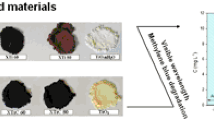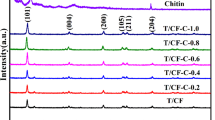Abstract
As a bio-recalcitrant organic pollutant in paper mill effluent, lignin is generally removed by an advanced oxidation process, such as a TiO2/H2O2 photocatalytic technique under irradiation with ultraviolet light, which only accounts for less than 5% of sunlight. Herein, we reported a TiO2/H2O2-based thermally-assisted photocatalytic process that allows lignin to be efficiently degraded under visible/near-infrared light at an elevated temperature. Adsorption of H2O2 on TiO2 nanoparticles and an increase of temperature facilitate the production and separation of charge carriers under near-infrared and visible light irradiation, accelerate carrier transfer at the TiO2-electrolyte interface and promote the production of hydroxyl radicals. A higher level of H2O2 addition results in an increased degradation rate of lignin, while the optimal temperature for the thermally-assisted photodegradation of lignin is 70°C. A charge carrier excitation and transfer process was proposed for the TiO2/H2O2 thermally-assisted photocatalytic process. This work describes a new method for the photodegradation of organic pollutants, such as residual lignin in paper mill effluent, using wide band gap semiconductors under visible and near-infrared light irradiation.
摘要
木素是一种生物难降解有机物. 造纸工业废水中的木素通常利用诸如TiO2/H2O2紫外光催化技术之类的高级氧化技术去除, 但紫外光在太阳光中的份额不足5%. 本文提出了一种TiO2/H2O2热辅助可见/近红外光催化技术, 利用该技术可在可见/近红外光照射下将木素有效地催化降解. H2O2在TiO2上的吸附及提高温度可促使光生电子在近红外光和可见光照射下向导带跃迁, 并与H2O2反应促进光生载流子的分离及羟基自由基的形成. 因此, 提高H2O2浓度和适当提高温度有助于提高木素的近红外光催化降解速率, 并在70°C时获得最大木素降解速率. 本文还根据实验与分析提出了TiO2/H2O2热辅助光催化体系降解木素时光生载流子的产生与传递机制.
Similar content being viewed by others
References
Ghaly MY, Jamil TS, El-Seesy IE, et al. Treatment of highly polluted paper mill wastewater by solar photocatalytic oxidation with synthesized nano TiO2. Chem Eng J, 2011, 168: 446–454
Ma YS, Chang CN, Chiang YP, et al. Photocatalytic degradation of lignin using Pt/TiO2 as the catalyst. Chemosphere, 2008, 71: 998–1004
Fernandes L, Lucas MS, Maldonado MI, et al. Treatment of pulp mill wastewater by Cryptococcus podzolicus and solar photo-Fenton: a case study. Chem Eng J, 2014, 245: 158–165
Merayo N, Hermosilla D, Blanco L, et al. Assessing the application of advanced oxidation processes, and their combination with biological treatment, to effluents from pulp and paper industry. J Hazard Mater, 2013, 262: 420–427
Brink A, Sheridan CM, Harding KG. The Fenton oxidation of biologically treated paper and pulp mill effluents: a performance and kinetic study. Process Safety Environ Protection, 2017, 107: 206–215
Oturan MA, Aaron JJ. Advanced oxidation processes in water/ wastewater treatment: principles and applications. a review. Critical Rev Environ Sci Tech, 2014, 44: 2577–2641
G. Covinich L, I. Bengoechea D, J. Fenoglio R, et al. Advanced oxidation processes for wastewater treatment in the pulp and paper industry: a review. Am J Environ Eng, 2014, 4: 56–70
Subramonian W, Wu TY, Chai SP. Photocatalytic degradation of industrial pulp and paper mill effluent using synthesized magnetic Fe2O3-TiO2: treatment efficiency and characterizations of reused photocatalyst. J Environ Manage, 2017, 187: 298–310
Hermosilla D, Merayo N, Gascó A, et al. The application of advanced oxidation technologies to the treatment of effluents from the pulp and paper industry: a review. Environ Sci Pollut Res, 2015, 22: 168–191
Biglari H, Afsharnia M, Alipour V, et al. A review and investigation of the effect of nanophotocatalytic ozonation process for phenolic compound removal from real effluent of pulp and paper industry. Environ Sci Pollut Res, 2017, 24: 4105–4116
Jiménez-Tototzintle M, Oller I, Hernández-Ramírez A, et al. Remediation of agro-food industry effluents by biotreatment combined with supported TiO2/H2O2 solar photocatalysis. Chem Eng J, 2015, 273: 205–213
Sang Y, Liu H, Umar A. Photocatalysis from UV/vis to near-infrared light: towards full solar-light spectrum activity. Chem-CatChem, 2015, 7: 559–573
Gao W, Liu W, Leng Y, et al. In2S3 nanomaterial as a broadband spectrum photocatalyst to display significant activity. Appl Catal B-Environ, 2015, 176-177: 83–90
An J, Zhang G, Zheng R, et al. Removing lignin model pollutants with BiFeO3–g-C3N4 compound as an efficient visible-light-heterogeneous Fenton-like catalyst. J Environ Sci, 2016, 48: 218–229
Li H, Lei Z, Liu C, et al. Photocatalytic degradation of lignin on synthesized Ag–AgCl/ZnO nanorods under solar light and preliminary trials for methane fermentation. Bioresource Tech, 2015, 175: 494–501
Gong J, Imbault A, Farnood R. The promoting role of bismuth for the enhanced photocatalytic oxidation of lignin on Pt-TiO2 under solar light illumination. Appl Catal B-Environ, 2017, 204: 296–303
Priya SS, Deshpande A, Dwarakanath R. Visible light solar photocatalytic degradation of pulp and paper wastewater using dyesensitized TiO2. Int J Res Eng Technol, 2015, 4: 200–204
Chen H, Liu W, Qin Z. ZnO/ZnFe2O4 nanocomposite as a broadspectrum photo-Fenton-like photocatalyst with near-infrared activity. Catal Sci Technol, 2017, 7: 2236–2244
Chen J, Liu W, Gao W. Tuning photocatalytic activity of In2S3 broadband spectrum photocatalyst based on morphology. Appl Surf Sci, 2016, 368: 288–297
Tanaka K, Calanag RCR, Hisanaga T. Photocatalyzed degradation of lignin on TiO2. J Mol Catal A-Chem, 1999, 138: 287–294
Jayakrishnan R, Sebastian T, John TT, et al. Photoconductivity in sprayed β-In2S3 thin films under sub-band-gap excitation of 1.96 eV. J Appl Phys, 2007, 102: 043109–043109
Zhao H, Wu Q, Hou J, et al. Enhanced light harvesting and electron collection in quantum dot sensitized solar cells by TiO2 passivation on ZnO nanorod arrays. Sci China Mater, 2017, 60: 239–250
Li LB, Wu WQ, Rao HS, et al. Hierarchical ZnO nanorod-onnanosheet arrays electrodes for efficient CdSe quantum dot-sensitized solar cells. Sci China Mater, 2016, 59: 807–816
Yang MQ, Weng B, Xu YJ. Synthesis of In2S3–CNT nanocomposites for selective reduction under visible light. J Mater Chem A, 2014, 2: 1710–1720
Park K, Zhang Q, Garcia BB, et al. Effect of annealing temperature on TiO2-ZnO core-shell aggregate photoelectrodes of dye-sensitized solar cells. J Phys Chem C, 2011, 115: 4927–4934
Sen SK, Riga J, Verbist J. 2s and 2p X-ray photoelectron spectra of Ti4+ ion in TiO2. Chem Phys Lett, 1976, 39: 560–564
Liu G, Liu L, Song J, et al. Visible light photocatalytic activity of TiO2 nanoparticles hybridized by conjugated derivative of polybutadiene. Superlattices Microstruct, 2014, 69: 164–174
Cai Y, Wang HE, Zhao X, et al. Walnut-like porous core/shell TiO2 with hybridized phases enabling fast and stable lithium storage. ACS Appl Mater Interfaces, 2017, 9: 10652–10663
Ohno T, Masaki Y, Hirayama S, et al. TiO2-photocatalyzed epoxidation of 1-decene by H2O2 under visible light. J Catal, 2001, 204: 163–168
Li X, Chen C, Zhao J. Mechanism of photodecomposition of H2O2 on TiO2 surfaces under visible light irradiation. Langmuir, 2001, 17: 4118–4122
Boonstra AH, Mutsaers CAHA. Adsorption of hydrogen peroxide on the surface of titanium dioxide. J Phys Chem, 1975, 79: 1940–1943
Acknowledgements
The project was funded by the National Natural Science Foundation of China (31270625).
Author information
Authors and Affiliations
Corresponding author
Additional information
Jun Chen received his bachelor degree in printing engineering from Qilu University of Technology in 2012. Now he is a Master candidate in pulp and paper engineering under the supervision of Professor Wenxia Liu at Qilu University of Technology. His research interests are related to the photocatalytic degradation of organic pollutant and controlled depolymerization of lignin.
Wenxia Liu received her bachelor and Master degrees in pulp and paper engineering from Shaanxi University of Science and Technology in 1985, 1988, respectively. She joined the Faculty of Pulp and Paper Engineering, Qilu University of Technology in 1988. In 2000, she received her doctoral degree in pulp and paper engineering from Tianjin University of Science and Technology. Her research interests focus on wet end chemistry, synthesis and application of nanomaterials in pulp and paper making industry.
Electronic supplementary material
Rights and permissions
About this article
Cite this article
Chen, J., Liu, W., Li, Z. et al. Thermally-assisted photodegradation of lignin by TiO2/H2O2 under visible/near-infrared light irradiation. Sci. China Mater. 61, 382–390 (2018). https://doi.org/10.1007/s40843-017-9176-8
Received:
Accepted:
Published:
Issue Date:
DOI: https://doi.org/10.1007/s40843-017-9176-8




